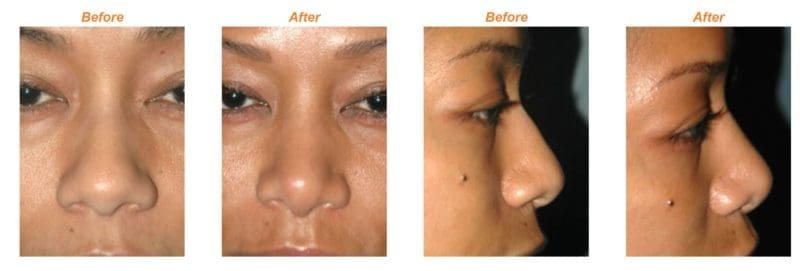What is Ethnic Rhinoplasty?
‘Ethnic Rhinoplasty’ is a medical term used to refer to rhinoplasties that ensure patients retain their ethnic identities. Ethnic rhinoplasty can be considered as an opposite of the ‘one nose fits all’ mentality. Although the various ethnicities have different heritages in terms of anatomical configurations, research has shown that the general looks of all of them are similar. The similarities in the width of cheekbones, the distance between chin and mouth, and the size of eyes are similar and can undergo rhinoplasty to look natural. The quality of rhinoplasty ultimately will depend on how well a surgeon is able to evaluate a patient’s entire face and not just the nose. The term ‘ethnic’ is used when referring to rhinoplasty that involves certain physical characteristics for a specific ethnicity. Many surgeons have used the term ‘ethnicity’ when referring to rhinoplasty of darker pigmented skins. Handling a darker skin is quite different to handling lighter skin as it comes with the scar and hyperpigmentation risks.

Who can undergo ‘Ethnic Rhinoplasty’?
‘Ethnic Rhinoplasty’ is a kind of plastic surgery that can be performed on people from the non-Caucasian heritage including people of African, Asian, Middle Eastern, or Hispanic heritage. These categories of people can go through this kind of surgery to enhance the way their noses appear. Many people prefer ethnic rhinoplasty because it facilitates unique tailoring of the outcome for every person. As such, one is able to decrease or increase his or her nose size, reshape his or her boxy or bulbous nasal tip, re-contour nostrils that are not proportional or are misshaped, straighten a nose that is misaligned, and deal with nasal breathing problems that come with a deviated septum or any structural issue that affects his or her nostrils.
People with nasal dorsum can also undergo ethnic rhinoplasty with the aim of correcting it. The nasal dorsum is commonly known as a nasal bridge. In the past, many plastic surgeons used implants or rib cartilages on Asians and African-American patients with the aim of increasing the nasal bridge volume. The use of implants and rib cartilages, however, was not ideal because they could infect patients while the rib cartilage could wrap with time. This has made rhinoplasty a viable option that can be combined with diced cartilage fascia rafts (DCFG) in repairing the nasal bridge. Using the DCFG method in dealing with nasal bridge involves the use of ear or septal cartilage that are wrapped in tissues with fiber from the scalp, making it possible to develop a more natural and flexible implant with a patient’s own tissue.
What are the two common forms of Rhinoplasty?
Although the term ‘ethnic rhinoplasty’ has been used to refer to all non-Caucasian ethnicities, the term itself can be misleading to patients and the general public as it does not consider the differences in the anatomy of such ethnicities. Surgeons acknowledge that the diversity of nose anatomy of non-Caucasian communities requires different approaches to conducting rhinoplasty depending on each person’s ancestry.
The two main forms of Rhinoplasty are:
- African American Rhinoplasty
There are few surgeons who specialize in African American Rhinoplasty. African Americans who would wish to undergo rhinoplasty have different needs compared to Asians and Indians who may also wish to undergo the same surgery.
The main concerns of African Americans are:
- Reducing their wide nasal ala or nostrils
One of the main problems that African Americans have in terms of their nasal anatomy is their wide nasal ala. Many of the patients who want to undergo rhinoplasty and are of the African American origin would wish to have their nasal tip reshaped by thinning it. Surgeons who help patients to reshape their nasal tips look at the lower third of their patient’s nose and then use tip lobule and cartilages to help support their patient’s nostrils.
- Refining their nasal dorsum or bridge
Rhinoplasty is a common surgery remedy for African Americans who want their nasal dorsum refined. This is because most of them seek the rhinoplasty treatment because “their noses are too low, too wide, or both”. They seek rhinoplasty as a treatment that will enable them to refine their wide or low nostrils.
- Asian Rhinoplasty
Asians tend to have small noses. As such, patients of the Asian origin who seek rhinoplasty treatment often want their nostrils enlarged. This is a complete opposite of what patients of the Caucasian origin seek. When one compares the nostrils of people of Asian origin with people of Caucasian origin, Asians’ noses have a lesser projection hence the need to make them larger. This makes it difficult for surgeons specialized in a Caucasian nose to refine the Asian nose. As a result, Asian patients are better of dealing with surgeons with a specialty in Asian rhinoplasty. When an Asian patient decides to undergo rhinoplasty, the surgeon will need to use special cartilages to reinforce and buttress the nose’s inner structure properly.
Dr. Andrew Jacono, a rhinoplasty surgeon in New York is considered to be one of the city’s top plastic surgeons. He is Dual Board Certified and performs Reconstructive Surgery, as well as other procedures, on Long Island’s Gold Coast and in Manhattan.

One Comment
karen albert winslow
Its a nose job either way. The dont like their nose size, shape or bulb. They are doing it because they want to change their ethnic features.